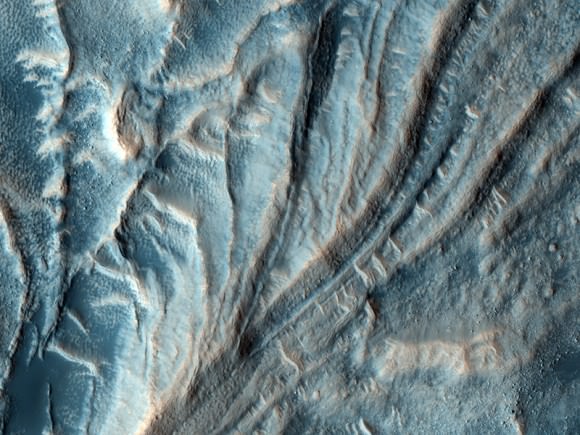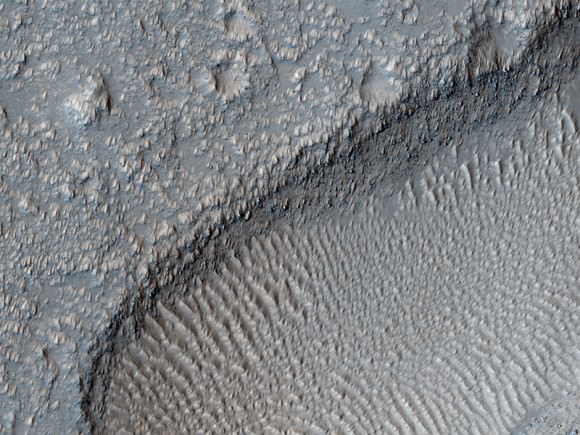[/caption]
I don’t know about the rest of you, but I could look at images from the HiRISE camera on the Mars Reconnaissance Orbiter all day…and there are days I have spent a great deal of time perusing through the gorgeous, high-resolution images. Here are just a few of the latest images the HiRISE team has released. This first one is one of the most stunning yet. It’s part of a dune field in a crater called Russell Crater (53.3S and 12.9E.) The dune field itself is roughly 30 kilometers long, and appears to have formed from windblown material trapped by the local topography. The image was taken in October 2008, during the Mars’ southern hemisphere’s deep winter, where temperatures are low enough to allow the carbon dioxide frost to be stable. Looking closely, you can see the frost, visible on the slopes that don’t get full sunlight. The team says this region is the target of a long term monitoring program by HiRISE.
And there’s more…

This image is of a so called “flow feature” within Moreux Crater, located at 42N and 44.6E on the edge of Mars’ highlands/lowlands boundary. The crater itself is roughly 135 kilometers in diameter. During an impact event that creates a crater, central uplifts or mounds form on the floor of the crater in craters larger than 7km in diameter. This image focuses on a portion of the Moreux central uplift that apparently broke off and slid away, forming a type of giant landslide. Interesting hummocks, swirls and ridges are found on the surface of the landslide. There are also distinct, almost circular depressions of unknown origin near the foot of the flow. Both light and dark toned dunes later formed on this landform.

This image shows features on a volcano called Hecates Tholus. This volcano is located in the northern hemisphere of Mars and is the northernmost of three volcanoes within Elysium Planitia. The “braided” channels seen in this image appear to have formed by water carving into young lava flows. Like braided rivers on Earth, they consist of a network of small channels, often separated by small streamlined “islands.” The fact that they are braided and have streamlined islands has led scientists to interpret these landforms as being created by water (fluvial) rather than by volcanic activity, and perhaps even more than one water-related event created these features, since there are fine sediments and multiple channels.
The water that potentially formed the braided channels may have been released when hot lava came into contact with ground ice.
For more images, as well as more information on these images and high resolution versions, see the HiRISE site. But watch out, you might be there for awhile — there’s lots to look at!
Source: HiRISE


Beautiful images…. Past days I found 3d photos of the solar system in the JPL site. Some craters on Mars are cuttting your breath, if the expression is correct.
Looking at photos for work is very usufull too.You see the things as they really are, in detail, you can notice things that you didn’t notice before, or understand them better.
3 years ago, when I first saw the pulsar at the Crab Nebula for example, I didn’t pay much attention. But when I red that the star is spinning, I realizzed that what I was looking was exactly its rotation, before my eyes…it was really fascinating 🙂